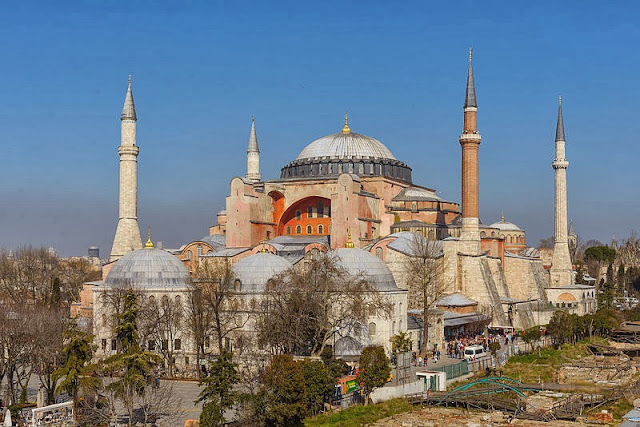Hagia Sophia -Holy Wisdom
Hagia Sophia -Holy Wisdom
The Byzantine church of Hagia Sophia (Holy Wisdom) in Constantinople [modern Istanbul, Turkey] ranks as one of the greatest architectural achievements of all time. Built in the short span of five years, 532 to 537, the church is remarkable for the design of its immense dome and the magnificence of its richly appointed interior. The Emperor Justinian commissioned Hagia Sophia to replace an earlier church of the same name that stood on the same site. The latter, itself a replacement for an earlier church, had burned down in the disastrous Nika Riots of 532. These riots, so-named for the chant “nika” (“win”) uttered by rebels aiming to overthrow the government, resulted in tens of thousands of deaths and the destruction of a large portion of the city of Constantinople. Construction of the new church began within weeks of the suppression of the revolt.
Byzantine sources seldom list the names of individual architects, yet in this case we are fortunate to know the two men responsible for the ground breaking design: Anthemios of Tralles and Isidoros of Miletos. They were not architects in the traditional sense but scholars trained in mathematics and physics. Little was known about them and have no other buildings with which to associate them, but their fame is assured through the construction of this one exceptional edifice. The effect was immediate: Justinian, upon entering the newly completed church, is said to have exclaimed, “Solomon, I have outdone you!”
The building has survived numerous earthquakes, reconstructions, and political vicissitudes that have transformed it from church (Orthodox and Catholic for a while after the 4th Crusade) to mosque to museum. Time has taken its toil, yet Hagia Sophia continues to amaze just as it did when Justinian first set foot in the church 1,470 years ago.
The inside of Hagia Sophia was once extensively adorned with mosaics and colored marbles from throughout the empire. In 558 the eastern part of the dome collapsed, necessitating the first of many reconstructions. When the church was rededicated in 563, Paul the Silentiary wrote a poem describing the interior . He tells us that gold mosaics covered the dome, half-domes, tympanum walls, and ceilings of the narthex, aisles, galleries, and vestibules a space estimated to cover more than 4 acres. The decoration on this gold ground consisted of colored geometric and floral designs with numerous crosses done in outline, including one at the center of the great dome.
It is clear from Paul’s description that the interior of Hagia Sophia contained no figural mosaics at the time of Justinian. This comes as a surprise when one considers other contemporary churches such as San Vitale in Ravenna [Italy] with its splendid mosaics of Justinian and Theodora on the walls of the sanctuary and the Church of the Virgin at the Monastery of St. Catherine at Mount Sinai with its famous apse mosaic of the Transfiguration. Even the Great Palace in Constantinople was decorated with floor mosaics depicting lively scenes of hunters pursuing their prey. The figural mosaics that do survive from Hagia Sophia, including one depicting Justinian, all date from the 9th century and later.
The initial aversion to figural scenes has been explained in numerous ways but two factors are likely to have played a role in the decision-making process: the rapid pace of construction and the immense size of the church. It is simply more time consuming to make mosaics depicting people and it is extremely difficult to “read” such scenes high up on the walls and ceilings of such a large structure. In addition, perhaps there was a conscious decision to avoid anything that would distract one’s attention away from the mystical experience created by the architecture itself.
Light enters Hagia Sophia through a series of windows, 40 of which are strategically located at the base of the dome. According to the historian Procopius, the dome seemed to hang suspended “on a golden chain from Heaven.” Light struck the gilded mosaics and was reflected and diffused throughout the interior, dissolving matter and creating an environment far removed from the outside world. This brings us back to Anthemios, the architect/physicist who was especially interested in optics, the science of light and vision. Through his manipulation of light and space he was able to create a building whose interior evoked the heavenly kingdom of Jerusalem. In an age where there was no separation of Church and State, it was all about science in the service of religion.




Comments
Post a Comment